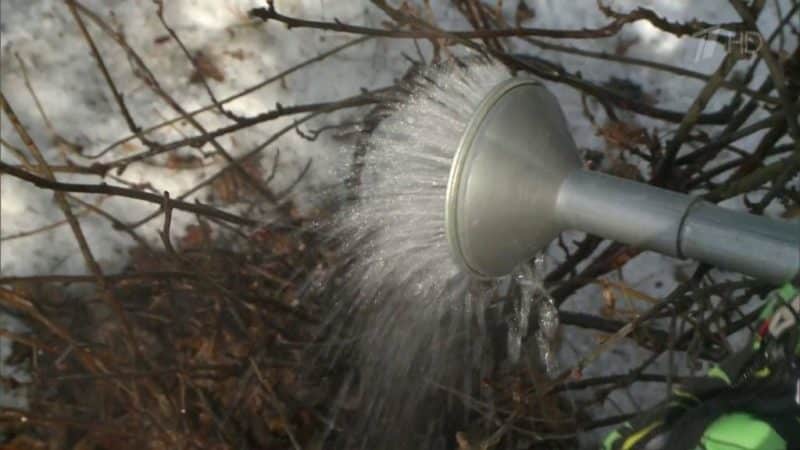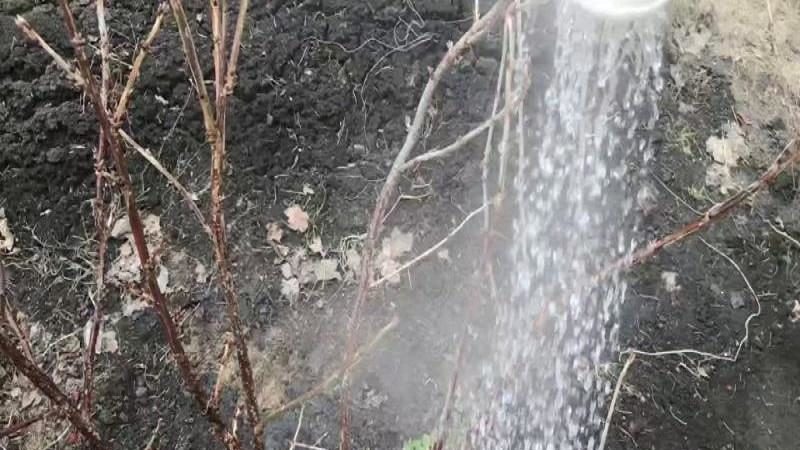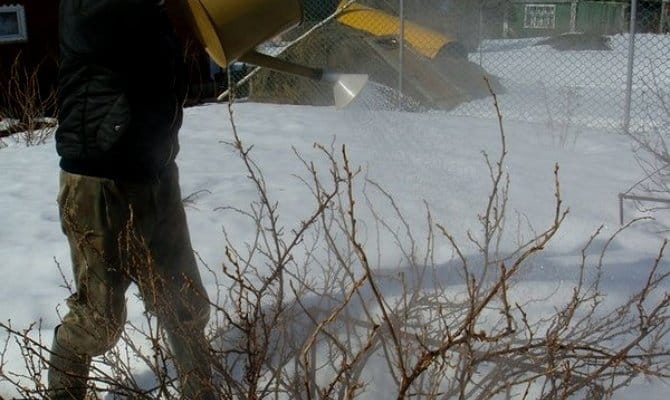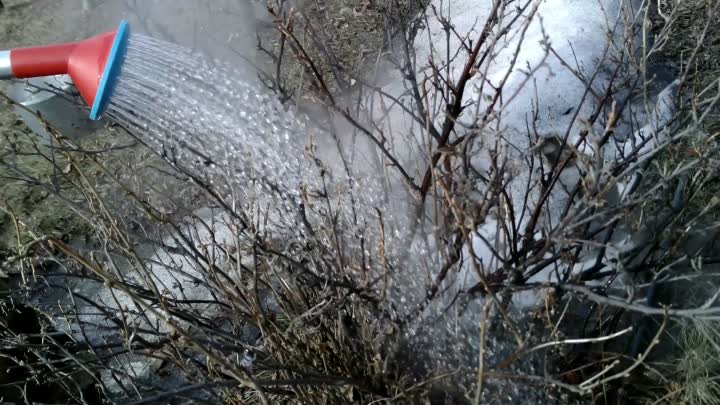Life hack for gardeners: how to properly pour boiling water over currants in the spring and what it will give
Currant is an unpretentious garden shrub, undemanding to soil and care. However, without proper attention, it will produce fewer and fewer berries from year to year. One of the agrotechnical procedures necessary for the plant is spring watering with boiling water. Let's figure out how to properly pour boiling water over currants in the spring and why to do it.
Why water currants with boiling water in spring?

Currant often becomes a winter refuge for various pests and their larvae. Not only insects that are destructive to it, but also pests of other garden crops can settle in the bark of a shrub. Treatment with hot water causes the protein of the larvae to coagulate and they die.
Important! This treatment is especially important to combat the currant bud mite, which settles in the buds and reduces the yield and growth of currants.
Also, such watering allows you to fight fungal diseases, since the body of the fungus itself and its spores are extremely sensitive to temperature changes. Watering even with simple hot water at a temperature above +40°C disrupts the natural processes of development of parasitic fungi.
Is this necessary?
The procedure is not strictly mandatory. However, such treatment makes it possible to improve not only the bushes themselves, but also the area as a whole, while reducing the risk of overwintering insects transferring to awakening plants.
Advantages and disadvantages of watering

Watering currants with boiling water has many supporters and opponents. Despite the obvious advantages, the method does not protect the bush 100% and is not universal.
pros:
- destruction of insects, their pupae and larvae overwintering in the buds and bark;
- reducing the risk of spreading fungal infections;
- increasing the overall resistance of the bush to diseases;
- increase in the number of peduncles;
- general improvement of the site;
- environmental friendliness and simplicity of the method.
Minuses:
- spores of some fungi are resistant to such treatment;
- no protection against secondary infection;
- if caution is not observed, there is a risk of scalding the plant;
- the risk of losing the harvest if the procedure deadlines are violated.
Optimal times for dousing currants
Due to differences in climate, different lengths of winter and weather conditions of the current year, the timing of the procedure not only varies in regions, but also shifts from year to year. If you water too early, there is a risk of “waking up” the plant, and if you water too late, you risk scalding the awakening buds. Gardeners recommend focusing on the beginning of snow melting and daytime temperatures rising to +10°C.
Important! The main condition: the procedure is carried out before the sap begins to flow and the kidneys awaken.
Depending on the conditions of the past winter, the average duration of the procedure is as follows:
- Central Russia and Moscow region - the first and second ten days of March;
- Northern regions (Urals, northern part of Siberia) – the first and second ten days of April;
- Southern Siberia – first ten days of April;
- South – first ten days of March.
Weather
Based on current weather conditions and the conditions of the past winter, gardeners build a work schedule, including watering currants. The vegetation processes of the bush begin early: in the southern regions they can begin as early as the third ten days of March, in the northern regions, Siberia and the Urals - in April. Therefore, it is necessary to water the plant with boiling water in advance.
The optimal daytime temperature for watering the plant ranges from +5 to +10°C. Experienced gardeners do not recommend watering with boiling water immediately after the snow begins to melt - then the risk of frost is still high, and because of this, the likelihood of early awakening of the bush increases. It is best to carry out agrotechnical practices when the last snow lies.
Reference. In the northern regions, snow can lie until May, sometimes until June, so this guideline is not the most correct when choosing the time of the procedure.
How to water currants correctly

There are several processing methods: simple watering with boiling water, using boiling water with urea or potassium permanganate (potassium permanganate). In addition to the direct effect of hot water, additional disinfectants increase the effectiveness of the procedure as a whole.
The methods differ only in the working solutions, but the process itself is the same and is as follows:
- The bushes are inspected and the shoots are tied into a bundle for better processing.
- The water is boiled and, if necessary, additional components are added to the desired concentration.
- Boiling water is poured into a metal watering can with a fine-mesh nozzle. In contact with the metal, the water will cool to the desired temperature.
- Before watering, the water is additionally measured using a thermometer. The optimal indicator is +60…+80°С.
- The bushes are doused, directing the stream to the center of the plant and capturing all the shoots without exception.
- Processing one bush should take no more than 5-7 seconds, for large bushes – no more than 10 seconds.
- Additionally, they spill soil around the bush within a radius of 0.5 m.
If the roots protrude above the ground, they should be covered with any waterproof material so as not to burn them.
Simple watering with boiling water
Watering with simple boiling water is not difficult. It is only important to observe the temperature limits and the distance from the watering can to the bush - it should not be less than 10 cm, otherwise you can burn the branches.
Important! You cannot scald the bush a second time, even if some of the branches are missing.
Boiling water with urea

Urea (carbamide) not only helps in pest control, but also serves as an additional method of saturating the plant with nitrogen. Nitrogen from the working solution is easily absorbed by the kidneys and bark. In addition, urea slows down flowering and protects the crop from frost.
The working solution is prepared as follows:
- 10 liters of water;
- 50 g of copper sulfate;
- 0.5 kg of urea.
Boiling water with potassium permanganate
Potassium permanganate is one of the best remedies for fighting fungal infections. It destroys not only spores, but also the body of the fungus itself, and increases the effectiveness of boiling water against many pests, such as mites.
Reference. If the soil is saturated with potassium, treatment with potassium permanganate is extremely undesirable.
The working solution is prepared from 10 liters of boiling water and 5 g of potassium permanganate. This amount is contained in one third of a level teaspoon. Potassium permanganate is thoroughly stirred until the crystals are completely dissolved. Undissolved particles can cause burns to the plant, so dilution must be carefully monitored.
An alternative to watering is using a steam cleaner.
There is an alternative method, which some gardeners consider fundamentally more convenient and safer - using a steam cleaner. Hot steam under pressure has a similar effect to boiling water on insects and fungi, but is considered safer for the plant itself. Any steam generator can be used. The advantage of this treatment is that there is no need to boil large amounts of water and carry heavy watering cans. Steam also penetrates more actively into small cracks in the bark, where fungi and insects can settle, which generally increases the effectiveness of the procedure.
When carrying out a procedure using a steam cleaner, you need to know the temperature it produces at the outlet. This is usually indicated in the instructions, but if there is no data, you can use a regular thermometer for measurement. The temperature of the steam reaching the shoots should be in the range from +60 to +80°C.
This is interesting:
How and with what to spray currants in the spring against pests and diseases
Step-by-step instructions on how to prune currants in the spring for a good harvest
Conclusion
Watering with boiling water is an environmentally friendly and effective procedure for improving the health of currant bushes. Of course, its effectiveness is significantly lower than that of chemical fungicides and insecticides. You can increase efficiency by adding potassium permanganate or urea to boiling water. The method is suitable for gardeners who do not want to once again resort to chemical methods of protecting fruit and berry crops from insects and fungal infections.